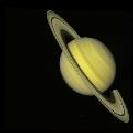- About Jodrell Bank Observatory
- On-line Guide to Jodrell Bank Observatory
- The History of Jodrell Bank
- Behind the Scenes Tour
- The Lovell Telescope
- 2000-02 Lovell Telescope Upgrade
- Telescope Webcams
- Telescope Pointing Display
- Telescope Status Display
- Image Gallery
- General Astronomy Menu
- News from Jodrell Bank
- The Jodcast
- The Night Sky This Month
- Lovell Public Lectures
- Viewing the Night Sky
- Astronomical Almanac
- Jodrell Bank Study Menu
- Distance learning courses
- Undergraduate degrees
- Postgraduate degrees
The Night Sky January 2005
Compiled by Ian Morison
This page, updated monthly, will let you know some of the things that you can look out for in the night sky. It lists the phases of the moon, where you will see the naked-eye planets and some of the prominent constellations in the night sky during the month.
NEW! Observe 50 of the very best objects in the heavens - the Astronomical A-List
The Astronomical A-List
The Moon

6 day old Moon. Image by Ann Dittmer
To see more of Ann Dittmer's Lunar Images: Ann Dittmer's Lunar Photography
| new | first quarter | full moon | last quarter |
| Jan 10th | Jan 17th | Jan 25th | Jan 3th |
Some Lunar Images by Ian Morison, Jodrell Bank Observatory: Lunar Images
Highlights of the Month.
Late December/ Early January A chance to see a naked eye Comet
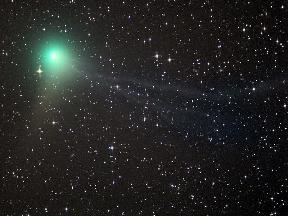
Comet Machholz
Image: Adam Block - NOAO,AURA,NSF
A comet that is already visible in southern skies will be visible at our latitudes in the latter part of this month and during January. Comet Machholz is rising up through Orion and Taurus and the chart below will show you where to look - just to the left of the dates given on the chart. on January 7th it will be just to right of the Pleiades Cluster in Taurus and some spectacular images are in prospect. Binoculars will help to pick it out initially and it should look like a little blob of cotton wool - perhaps with an obvious tail!
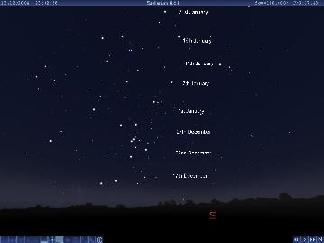
The Path of Comet Machholz
Image: IM/Stellarium.
Dawn, January 8thth - A conjunction of Venus and Mercury
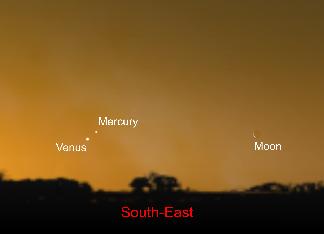
Pre-dawn on 8th January 2004 - a conjunction of Venus and Mercury
Image: Stellarium
Just before dawn on the 8th of January, there is a chance to see three planets in the south-east. Mercury and Venus are close together, just above the horizon to the east of the thin crescent Moon. You may also be able to spot Mars higher in the sky towards the south. Binoculars will help pick out Mercury!
See the International Space Station.

The International Space Station
Use the link below to find when the space station will be visible in the next few days. In general, the space station can be seen either in the hour or so before dawn or the hour or so after sunset - this is because it is dark and yet the Sun is not too far below the horizon so that it can light up the space station. As the orbit only just gets up the the latitude of the UK it will usually be seen to the south, and is only visible for a minute or so at each sighting. Note that as it is in low-earth orbit the sighting details vary quite considerably across the UK. The NASA website linked to below gives details for several cities in the UK. ( Across the world too for foreign visitors to this web page.)
Find details of sighting possibilities from your location from: Location Index
See where the space station is now: Current Position
The Planets

A montage of the Solar System. JPL / Nasa

A montage of Jupiter and its moons. Nasa
Jupiter may be easily seen the hours before dawn this month high to the east of south. It starts the month at magnitude -2 with an angular size of 36 arc seconds. During the month it brightens to -2.2 and an angular size of 39 arc seconds. January's "Sky and Telescope" has a chart on page 67 giving the positions of the 4 bright moons of Jupiter, first observed by Galileo. It is good to watch them as they weave their way around the planet and sometimes spot the dark shadow of one on the surface of Jupiter - or, if you are very lucky, even see one against the surface.
Saturn is passing below Castor and Pollux in Gemini. It is already rising in the east-north-east as nightfall begins. Its magnitude is about -0.2 and its angular size remains at 20 arc seconds during the month. The rings are still well open making Saturn a beautiful sight. A small telescope should easily show its brightest moon, Titan, but given an 4 inch (102mm) aperture or larger and dark transparent skies at least three more may be spotted. (Rhea and Dione are easiest and Tethys less so.) A chart on page 68 in January's "Sky and Telescope" will show you where to expect to find them.
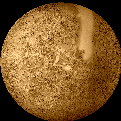
Mariner 10 composite image of Mercury. Nasa
Mercury rises just before the Sum at the beginning of the month . It reached greatest elongation - furthest in angle from the Sun as seen from the Earth - on December 29th so will remain visible low in the south-east just before dawn for the first week or so of January. It will not "twinkle" as much as any stars nearby so helping one to be sure that one has seen it. See the highlight above.
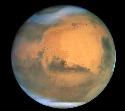
A Hubble Space Telescope image of Mars.
Jim Bell et al. AURA / STScI / Nasa
Mars is now visible in the pre-dawn sky in the east and shines at magnitude 1.6. Its angular size is just 4.2 arc seconds (increasing to 4.6 by the month's end) so it will just be seen as a salmon-pink or orange dot in telescopes. We will have to wait until late summer and autumn when Mars will be closest to us with an angular size of ~ 20 arc seconds before we will be easily able to see details on the surface with a small telescope. Though its angular size will be smaller than that in 2003 (when it was closest to us for ~60,000 years) it will be significantly higher in the sky and we will view it through less atmosphere. Our views of the surface may actually be better than then.
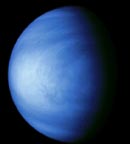
Venus showing some cloud structure
Venus is visible low in the pre-dawn sky, rising about 1 hour before the Sun and shining with at magnitude -3.7 in the east. The brightness stays almost constant at magnitude 3.7 this month as the reducing angular size (10.8 to 10.2 arc seconds) is compensated by the greater area that we see illuminated - the "phase" - which increases from 93 to 97% during the month. This correctly implies that it is now moving to the far side of the Sun from us so will not be seen after the first couple of weeks of December until it reappears as an "evening star" at the end of May.

Radar image showing surface features
Find more planetary images and details about the Solar System: The Solar System
The Stars
The Mid to Late Evening January Sky
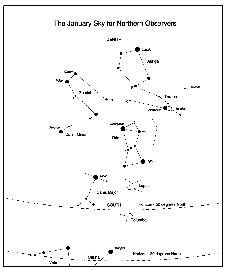
The January Sky in the south - mid to late evening.
The constellation Taurus
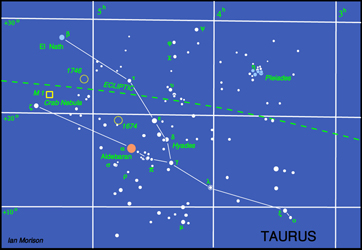
Taurus
This month the constellations Taurus is rising in the eastern sky after sunset and is south around 11pm.
Taurus is one of the most beautiful constellations and you can almost imagine the Bull charging down to the left towards Orion. His face is delineated by the "V" shaped cluster of stars called the Hyades, his eye is the red giant star Aldebaran and the tips of his horns are shown by the stars beta and zeta Tauri. Although alpha Tauri, Aldebaran, appears to lie amongst the stars of the Hyades cluster it is, in fact, less than half their distance lying 68 light years away from us. It is around 40 times the diameter of our Sun and 100 times as bright.
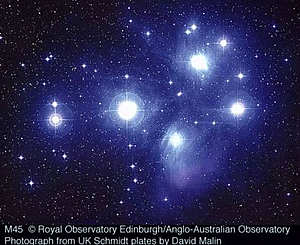
AAO Image of the Pleiades, M45, by David Malin
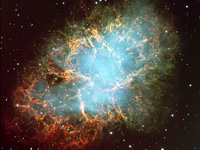
VLT image of the Crab Nebula
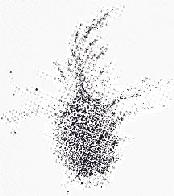
Lord Rosse's drawing of M1
The constellation Orion
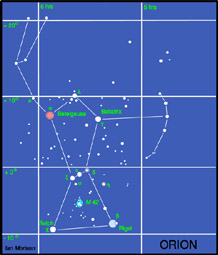
Orion
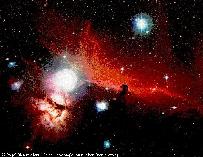
The Horsehead Nebula: Anglo Australian Observatory
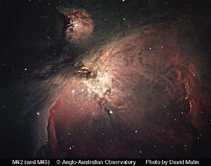
The Orion Nebula: David Malin
The constellation Ursa Major
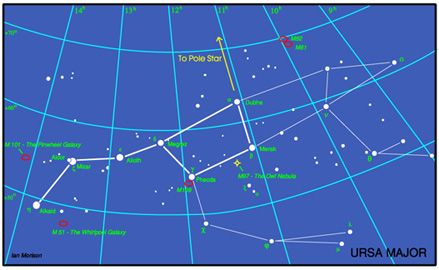
Ursa Major
The stars of the Plough, shown linked by the thicker lines in the chart above, form one of the most recognised star patterns in the sky. Also called the Big Dipper, after the soup ladles used by farmer's wives in America to serve soup to the farm workers at lunchtime, it forms part of the Great Bear constellation - not quite so easy to make out! The stars Merak and Dubhe form the pointers which will lead you to the Pole Star, and hence find North. The stars Alcor and Mizar form a naked eye double which repays observation in a small telescope as Mizar is then shown to be an easily resolved double star. A fainter reddish star forms a triangle with Alcor and Mizar. Ursa Major contains many interesting "deep sky" objects. The brightest, listed in Messier's Catalogue, are shown on the chart, but there are many fainter galaxies in the region too. In the upper right of the constellation are a pair of interacting galaxies M81 and M82 shown in the image below. M82 is undergoing a major burst of star formation and hence called a "starburst galaxy". They can be seen together using a low power eyepiece on a small telescope.
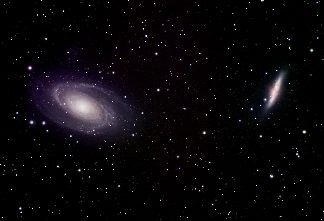
M81 and M82
Another, and very beautiful, galaxy is M101 which looks rather like a pinwheel firework, hence its other name the Pinwheel Galaxy. It was discovered in1781 and was a late entry to Messier's calalogue of nebulous objects. It is a type Sc spiral galaxy seen face on which is at a distance of about 24 million light years. Type Sc galaxies have a relativly small nucleus and open spiral arms. With an overall diameter of 170,000 light it is one of the largest spirals known (the Milky Way has a diameter of ~ 130,000 light years).
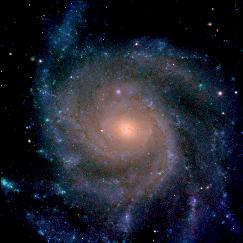
M101 - The Ursa Major Pinwheel Galaxy
Though just outside the constellation boundary, M51 lies close to Alkaid, the leftmost star of the Plough. Also called the Whirlpool Galaxy it is being deformed by the passage of the smaller galaxy on the left. This is now gravitationally captured by M51 and the two will eventually merge. M51 lies at a distance of about 37 million light years and was the first galaxy in which spiral arms were seen. It was discovered by Charles Messier in 1773 and the spiral structure was observed by Lord Rosse in 1845 using the 72" reflector at Birr Castle in Ireland - for many years the largest telescope in the world.
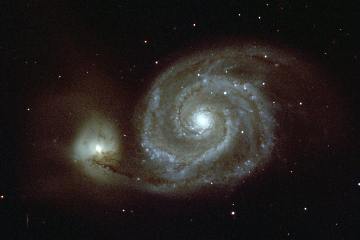
M51 - The Whirlpool Galaxy
Lying close to Merak is the planetary nebula M97 which is usually called the Owl Nebula due to its resemblance to an owl's face with two large eyes. It was first called this by Lord Rosse who drew it in 1848 - as shown in the image below right. Planetary nebulae ar the remnants of stars similar in size to our Sun. When all possible nuclear fusion processes are complete, the central core collpses down into a "white dwarf" star and the the outer parts of the star are blown off to form the surrounding nebula.
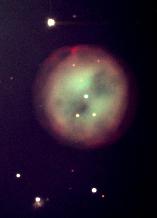
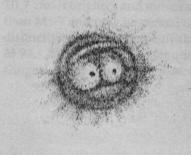
M97 - The Owl Planetary Nebula Lord Rosse's 1848 drawing of the Owl Nebula
Advice on viewing the night sky
Advice on buying and using binoculars.
Advice on buying and using a telescope.
NEW! Observe the Astronomical A-List
How to observe some of the best objects in the heavens
A Website to help you find your way around the sky: Your Sky
An excellent Constellations Web site: The Constellations
An excellent Astronomy Web site: The Society for Popular Astronomy
Learn more about the Universe by studying with Jodrell Bank astronomers: The Jodrell Bank Distance Learning page

